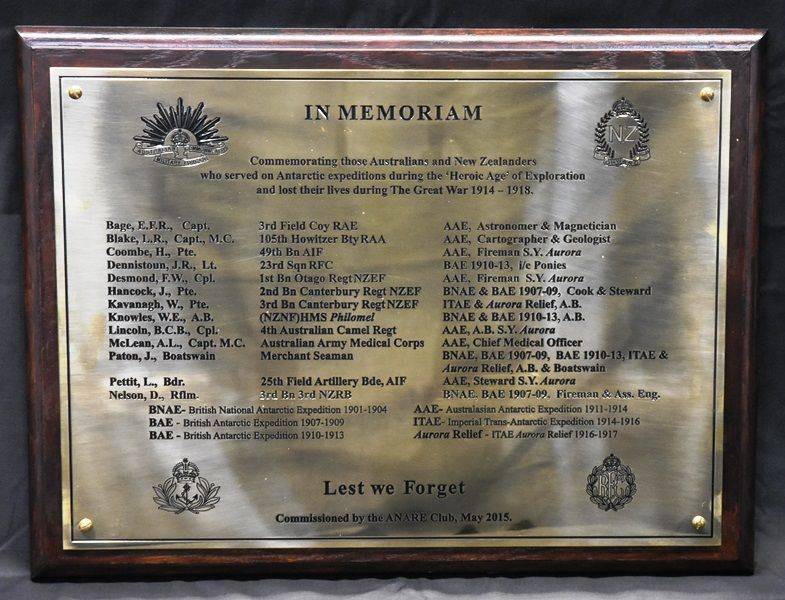
Home » Themes » Conflict » World War One
Australian Antarctic Division Honour RollPrint Page 

In this centenary of the Gallipoli Campaign, where the Great War ANZAC legend was born, the ANARE* Club has researched and recorded the names of 12 Australian and New Zealand expeditioners who served in the ‘Heroic Age of Antarctic Expeditions’ and who subsequently lost their lives in the First World War. The club commissioned and presented a Memorial Board in honour of these men to the Australian Antarctic Division, which is now on display at the Division’s headquarters in Kingston, Tasmania
The Heroic Age expeditions and their quest to reach the South Pole captured the public’s imagination in the early years of the 20th Century. With the outbreak of the Great War (1914–18), most of the men who were part of these expeditions signed up and paid a terrible price for their patriotism.
The names of the 12 Australian and New Zealand expeditioners who served either as members of a land party or manned the ships, and who lost their lives in the Great War have been recorded. While their names are usually listed on honour boards in their home towns or districts across Australia and New Zealand, their association with the Antarctic expeditions has been lost with the passage of time.
To address this, the Memorial Board honours those men who were part of the Australasian Antarctic Expedition 1911–14 and/or the Aurora Relief Expedition 1916–17; or had served on an earlier expedition and were either born in Australia or New Zealand or born elsewhere and enlisted in the Australian or New Zealand armed forces.
The mens’ fates roughly reflect the involvement of Australia and New Zealand in the Great War – one died at Gallipoli, five on the Western Front, one in Germany, two at sea, one in the Middle East, and two at home. It is also interesting to see the military skills to which they turned their hands – six of the eight sailors chose to serve in the Australian Imperial Force or the New Zealand Expeditionary Force rather than at sea. Lincoln moved to a ‘ship of the desert’, in the Camel Corps. Blake switched from geology to gunnery and Bage from astronomy to engineering. Dennistoun went from caring for ponies to flying. Clearly, adaptability was a characteristic of those early expeditioners!
Able Seaman William Knowles was the first to die. He was part of a small naval raiding party that landed on the Turkish coast in February 1915. Ambushed and forced to retire, Knowles succumbed to his wounds back on board HMS Philomel.
Captain Robert Bage, Mawson’s astronomer and magnetician, was killed at Gallipoli obeying an order that was questionable.
Lieutenant James Dennistoun, in charge of the ponies with Scott’s second expedition, joined the Royal Flying Corps as an observer. He was shot down and severely wounded in June 1916 and died of his wounds whilst a POW on August 9, 1916; the same day Leonard Pettit was killed in France. Later that year Joseph Hancock died of his wounds in France.
In 1917 Francis Desmond was killed-in-action at Messines Ridge and Harry Coombe was killed at Westhock Ridge. They had served together on the SY Aurora, which was herself lost that year with ‘Scottie’ Paton on board (the most experienced sailor of the heroic age), possibly sunk by mines from the German raider Wolf.
Bertrum Lincoln was killed in Jordan in 1918 and is commemorated on the Jerusalem memorial. Captain Leslie Blake, who had mapped Macquarie Island, died of his wounds a little more than a month before the Armistice, almost certainly from friendly fire; described officially and euphemistically as ‘by a stray shell’.
William Kavanagh, who had served on Shackleton’s Imperial Trans Antarctic Expedition (ITAE) and the Aurora Relief, was invalided home as a result of wounds and disabilities. He succumbed to post-war influenza, as did Captain Archibald McLean, who had been twice gassed.
All these men had survived the dangers of the Antarctic yet cheerfully volunteered for the higher risk of the battlefield. They did so that the world might be a better place, and it is most appropriate that their sacrifice be commemorated at the Australian Antarctic Division, the modern home of Australia’s Antarctic endeavour.
Shackleton, dedicating his account of the ITAE, has provided the appropriate words to describe this memorial:
To my comrades who fell in the white warfare of the south and on the red fields of France and Flanders.
Lest we Forget.
Herbert Dartnall, David Dodd and Joe Johnson
ANARE Club
†ANZAC – Australian and New Zealand Army Corps.
*ANARE Club – Australian National Antarctic Research Expeditions Club.
Excerpt from Australian Antarctic Magazine,
Issue 29: December 2015.
Location
| Address: | 203 Channel Highway, Australian Antarctic Division, Kingston, 7050 |
|---|---|
| State: | TAS |
| Area: | AUS |
| GPS Coordinates: | Lat: -42.987163 Long: 147.291325 Note: GPS Coordinates are approximate. |
Details
| Monument Type: | Honour Roll |
|---|---|
| Monument Theme: | Conflict |
| Sub-Theme: | WW1 |
| Actual Event Start Date: | 04-August-1914 |
| Actual Event End Date: | 28-June-1919 |
Dedication
| Approx. Monument Dedication Date: | May-2015 |
|---|
IN MEMORIAM
Commemorating those Australians and New Zealanders
who served on Antarctic Expeditons during the 'Heroic Age' of Exploration
and lost their lives during The Great War 1914 -1918.
[ Names ] [ Military Regiments ] [ Antarctic Expedtion & Position Held ]
BNAE - British National Antarctic Expedition 1901-1904
BAE- British Antarctic Expedition 1907-1909
BAE- British Antarctic Expedition 1910-1913
AAE - Australian Antarctic Expedition 1911-1914
ITAE- Imperial Trans-Antarctic Expedtion 1914 -1916
Aurora Relief - ITAE Aurora Relief 1916 -1917
Lest we Forget
Commisioned by the ANARE Club, May 2015.



